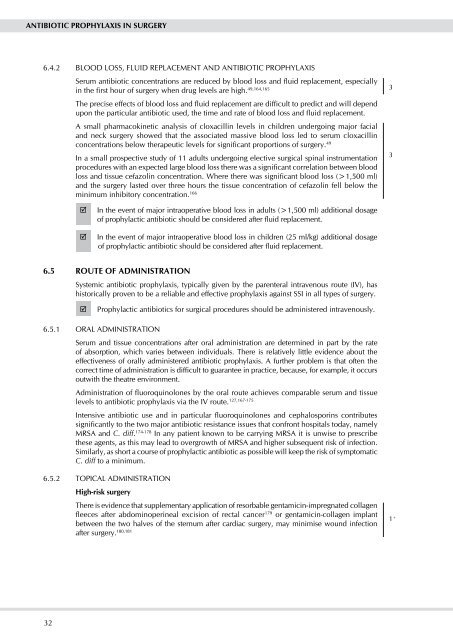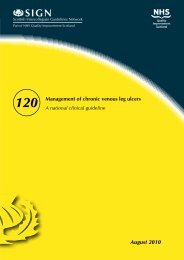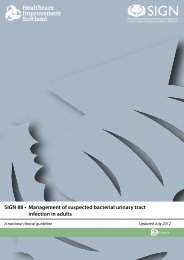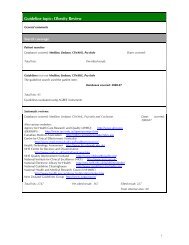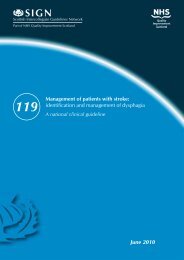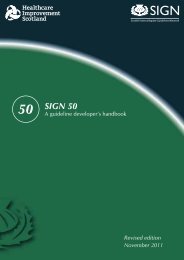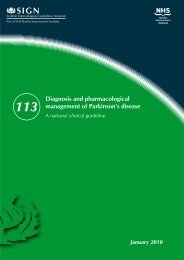Antibiotic prophylaxis in surgery. (SIGN Guideline No 104)
Antibiotic prophylaxis in surgery. (SIGN Guideline No 104)
Antibiotic prophylaxis in surgery. (SIGN Guideline No 104)
You also want an ePaper? Increase the reach of your titles
YUMPU automatically turns print PDFs into web optimized ePapers that Google loves.
<strong>Antibiotic</strong> prophylAxis <strong>in</strong> <strong>surgery</strong><br />
6.4.2 BlooD loSS, FluID REPlACEMENT AND ANTIBIoTIC PRoPHYlAxIS<br />
32<br />
Serum antibiotic concentrations are reduced by blood loss and fluid replacement, especially<br />
<strong>in</strong> the first hour of <strong>surgery</strong> when drug levels are high. 49,164,165<br />
The precise effects of blood loss and fluid replacement are difficult to predict and will depend<br />
upon the particular antibiotic used, the time and rate of blood loss and fluid replacement.<br />
A small pharmacok<strong>in</strong>etic analysis of cloxacill<strong>in</strong> levels <strong>in</strong> children undergo<strong>in</strong>g major facial<br />
and neck <strong>surgery</strong> showed that the associated massive blood loss led to serum cloxacill<strong>in</strong><br />
concentrations below therapeutic levels for significant proportions of <strong>surgery</strong>. 49<br />
In a small prospective study of 11 adults undergo<strong>in</strong>g elective surgical sp<strong>in</strong>al <strong>in</strong>strumentation<br />
procedures with an expected large blood loss there was a significant correlation between blood<br />
loss and tissue cefazol<strong>in</strong> concentration. Where there was significant blood loss (>1,500 ml)<br />
and the <strong>surgery</strong> lasted over three hours the tissue concentration of cefazol<strong>in</strong> fell below the<br />
m<strong>in</strong>imum <strong>in</strong>hibitory concentration. 166<br />
;<br />
;<br />
In the event of major <strong>in</strong>traoperative blood loss <strong>in</strong> adults (>1,500 ml) additional dosage<br />
of prophylactic antibiotic should be considered after fluid replacement.<br />
In the event of major <strong>in</strong>traoperative blood loss <strong>in</strong> children (25 ml/kg) additional dosage<br />
of prophylactic antibiotic should be considered after fluid replacement.<br />
6.5 route of ADm<strong>in</strong>istrAtion<br />
Systemic antibiotic <strong>prophylaxis</strong>, typically given by the parenteral <strong>in</strong>travenous route (Iv), has<br />
historically proven to be a reliable and effective <strong>prophylaxis</strong> aga<strong>in</strong>st SSI <strong>in</strong> all types of <strong>surgery</strong>.<br />
;<br />
Prophylactic antibiotics for surgical procedures should be adm<strong>in</strong>istered <strong>in</strong>travenously.<br />
6.5.1 oRAl ADMINISTRATIoN<br />
Serum and tissue concentrations after oral adm<strong>in</strong>istration are determ<strong>in</strong>ed <strong>in</strong> part by the rate<br />
of absorption, which varies between <strong>in</strong>dividuals. There is relatively little evidence about the<br />
effectiveness of orally adm<strong>in</strong>istered antibiotic <strong>prophylaxis</strong>. A further problem is that often the<br />
correct time of adm<strong>in</strong>istration is difficult to guarantee <strong>in</strong> practice, because, for example, it occurs<br />
outwith the theatre environment.<br />
Adm<strong>in</strong>istration of fluoroqu<strong>in</strong>olones by the oral route achieves comparable serum and tissue<br />
levels to antibiotic <strong>prophylaxis</strong> via the Iv route. 127,167-175<br />
Intensive antibiotic use and <strong>in</strong> particular fluoroqu<strong>in</strong>olones and cephalospor<strong>in</strong>s contributes<br />
significantly to the two major antibiotic resistance issues that confront hospitals today, namely<br />
MRSA and C. diff. 174-178 In any patient known to be carry<strong>in</strong>g MRSA it is unwise to prescribe<br />
these agents, as this may lead to overgrowth of MRSA and higher subsequent risk of <strong>in</strong>fection.<br />
Similarly, as short a course of prophylactic antibiotic as possible will keep the risk of symptomatic<br />
C. diff to a m<strong>in</strong>imum.<br />
6.5.2 ToPICAl ADMINISTRATIoN<br />
high-risk <strong>surgery</strong><br />
There is evidence that supplementary application of resorbable gentamic<strong>in</strong>-impregnated collagen<br />
fleeces after abdom<strong>in</strong>oper<strong>in</strong>eal excision of rectal cancer 179 or gentamic<strong>in</strong>-collagen implant<br />
between the two halves of the sternum after cardiac <strong>surgery</strong>, may m<strong>in</strong>imise wound <strong>in</strong>fection<br />
after <strong>surgery</strong>. 180,181<br />
3<br />
3<br />
1 +


